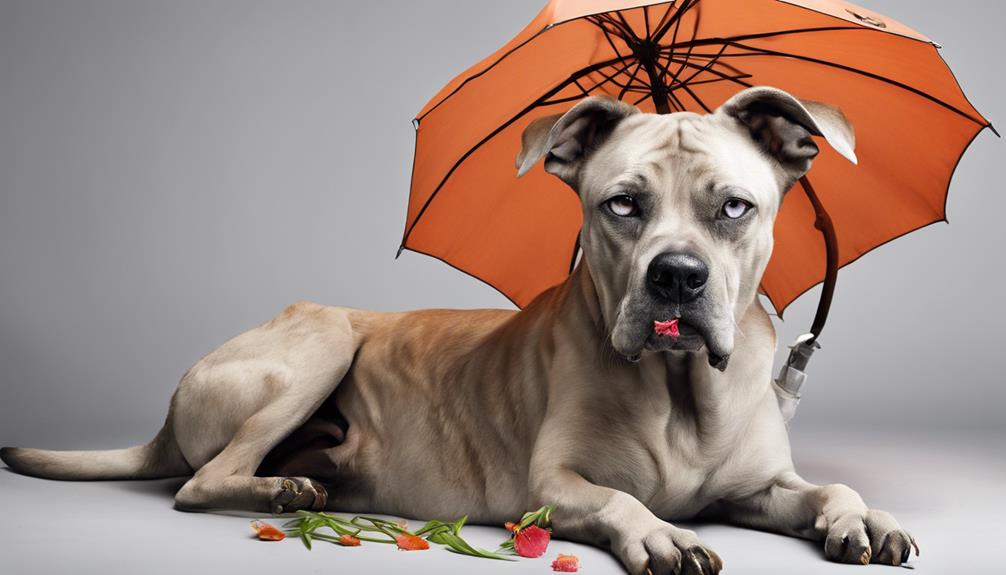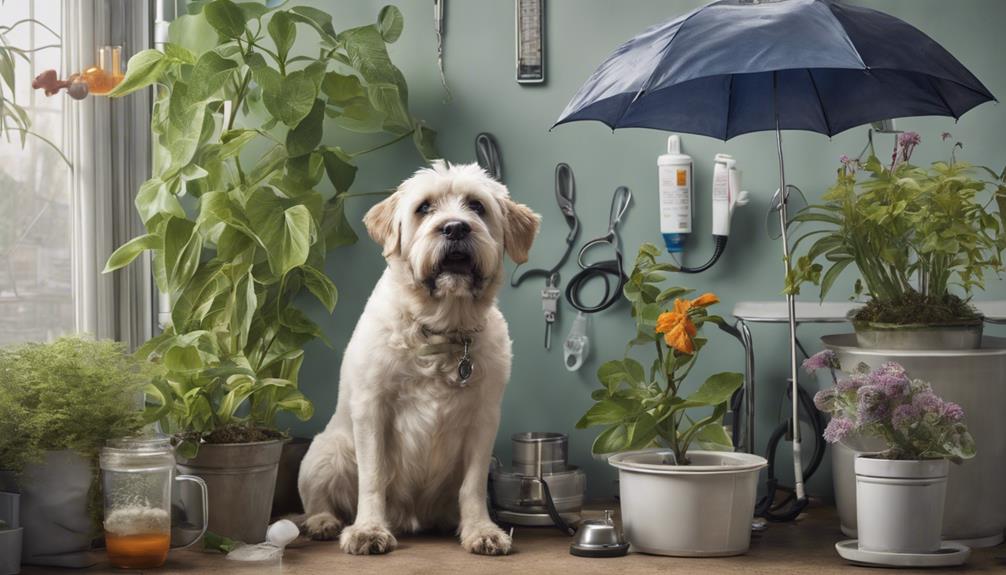To keep your dog safe, remember that umbrella plants can be toxic. The danger lies in substances like calcium oxalates, saponins, and terpenoids that cause oral irritation and gut issues. Watch out for symptoms such as vomiting, diarrhea, lethargy, dizziness, or tremors. Immediate action is essential if your pet ingests these harmful plants. Look for signs like drooling, mouth swelling, and agitation. Remember, prompt veterinary care is important if any symptoms appear. Taking quick action can make a significant difference in your pet's health.
Key Takeaways
- Toxic components include insoluble calcium oxalates, saponins, and terpenoids.
- Symptoms of toxicity in dogs include vomiting, diarrhea, lethargy, dizziness, and tremors.
- Immediate action is crucial upon ingestion to prevent severe health issues.
- Veterinary diagnosis involves evaluating symptoms and conducting diagnostic tests.
- Prevention involves elevating umbrella plants, keeping areas clean, and opting for safe plant alternatives.
Toxic Components in Umbrella Plants
Insoluble calcium oxalates, saponins, and terpenoids are the toxic components found in umbrella plants that pose a threat to dogs. When our furry friends ingest these plants, they can experience oral irritation and gastrointestinal distress due to the insoluble calcium oxalate crystals present. These crystals cause irritation in the mouth and throat, leading to discomfort and potential swelling.
The saponins and terpenoids in umbrella plants can further exacerbate the situation, causing additional gastrointestinal upset like vomiting and diarrhea.
Recognizing the symptoms of toxicity in dogs from umbrella plants, including vomiting, diarrhea, lethargy, dizziness, and tremors, is critical. These signs indicate that immediate action is necessary to address the ingestion of these toxic components. Hence, keeping these plants out of reach of our canine companions is vital to prevent such incidents from occurring.
Effects on Dogs From Toxicity

Exposure to toxic umbrella plants can lead to various symptoms in dogs, including drooling, mouth swelling, vomiting, and diarrhea. The toxic components in these plants, like insoluble calcium oxalates and terpenoids, can cause oral irritation and discomfort for our furry friends.
If a dog ingests these toxic plants, they may show signs of distress, agitation, and skin irritation. It's essential to seek immediate veterinary care if you suspect your dog has been affected by the toxicity of umbrella plants to prevent complications.
Gastrointestinal upset and respiratory distress are common effects of toxicity from these plants, which can also lead to potential long-term health issues for our canine companions. Remember, quick action and proper treatment can make a significant difference in the outcome for your pet.
Identifying Symptoms of Toxicity

Identifying symptoms of toxicity in dogs from umbrella plants is important for prompt intervention and proper care. When a dog ingests toxic components from these plants, they may exhibit various signs of poisoning. Look out for symptoms like drooling, mouth swelling, agitation, vomiting, diarrhea, and pawing at the face. These are common reactions indicating that the dog has been affected by the toxic elements in the umbrella plant.
Additionally, ingestion can lead to esophagus swelling and gastrointestinal tract irritation, causing immediate distress and discomfort for the dog. Respiratory distress and neurological symptoms can also manifest in severe cases. If you notice any of these symptoms in your dog after contact with an umbrella plant, it's essential to seek veterinary care promptly. Monitoring for adverse effects and acting swiftly can help manage umbrella plant poisoning symptoms effectively and safeguard the well-being of your furry friend.
Veterinary Diagnosis and Treatment

When a dog is suspected of ingesting an umbrella plant, veterinarians will evaluate symptoms and consider the history of plant consumption.
Diagnostic tests such as blood work and urinalysis may be conducted to confirm poisoning.
Treatment options for umbrella plant toxicity in dogs include decontamination, medication administration, and close monitoring to guarantee a safe recovery.
Diagnosis Methods Used
Upon arrival at the veterinary clinic, we carefully assess a dog's symptoms, history of plant ingestion, and perform diagnostic tests to diagnose umbrella tree poisoning. These tests may include blood work, urinalysis, and biochemistry profiles to evaluate the impact of the toxic substances on the dog's body.
In more severe cases, gastric lavage might be necessary to remove any remaining plant material from the stomach. Additionally, activated charcoal may be administered to help bind and eliminate toxins from the dog's system. Bringing a sample of the plant ingested can aid in accurate diagnosis and treatment planning.
These diagnostic methods help veterinarians determine the extent of umbrella tree poisoning and develop an effective treatment plan for the affected dog.
Treatment Options Available
Veterinary diagnosis and treatment options for umbrella plant poisoning in dogs involve a thorough evaluation of symptoms and ingestion history, followed by appropriate interventions to address toxicity and guarantee the dog's well-being. Decontamination methods such as gastric lavage and activated charcoal administration are common practices. IV fluids help flush out toxic compounds, while medications like diazepam may be used to manage symptoms. Monitoring of liver enzymes and CNS activity is vital for evaluating the dog's response to treatment. Bringing a portion of the plant to the veterinarian aids in diagnosis, especially in severe cases requiring airway intervention. Prompt veterinary care is essential to mitigate risks of GI upset and ensure a positive prognosis for the affected dog.
| Treatment | Description |
|---|---|
| Decontamination | Gastric lavage, activated charcoal |
| IV Fluids | Help flush out toxic compounds |
| Medications | Diazepam for symptom management |
| Monitoring | Liver enzymes and CNS activity evaluation |
Recovery and Prognosis for Dogs

With prompt treatment, the prognosis for dogs affected by umbrella tree poisoning greatly improves. If your furry friend has ingested or come into contact with this plant, it's essential to seek immediate veterinary care. Early intervention plays an important role in enhancing recovery chances, especially for smaller breeds and puppies.
The severity of symptoms and the quantity of the plant consumed also impact the prognosis. Once at the veterinarian's office, your dog may require overnight observation and a specialized diet to aid in their recovery. Delayed treatment can make the process more challenging, highlighting the importance of acting swiftly.
Preventative Measures for Pet Safety

After ensuring prompt treatment for umbrella tree poisoning, taking preventative measures for pet safety becomes essential to protect our furry companions from toxic plant exposure.
- Elevate Umbrella Trees: Placing them out of reach using high shelves or hanging planters can prevent pets from accessing them.
- Keep the Area Clean: Regularly clearing fallen leaves and debris around the plant reduces the risk of accidental ingestion by pets.
- Consider Safe Alternatives: Opt for pet-friendly plants like spider plants or African violets to avoid toxicity issues in your home.
- Choose Safe and Stylish Options: Pilea peperomioides and echeveria succulents are attractive plant choices that pose no harm to pets.
Prevention through thoughtful plant placement and regular clean-ups is essential for ensuring pet safety around toxic plants like Umbrella Trees. By following these simple steps, we can create a safe environment that allows our furry friends to thrive without the risk of poisoning from harmful plants.
Safe Alternatives for Pet-Friendly Homes

In creating a pet-friendly home environment, selecting safe alternatives to toxic umbrella plants is essential for maintaining the well-being of our furry companions. Spider plants, African violets, Pilea peperomioides, and echeveria succulents are excellent choices as safe alternatives.
Spider plants not only look stylish but also have air-purifying properties, making them a great indoor decor option that's safe for pets. African violets, with their vibrant colors, can brighten up your living space without posing any toxicity risks to your furry friends.
Pilea peperomioides and echeveria succulents are easy to care for and pet-friendly, thriving in various indoor conditions. These plants not only enhance the aesthetics of your home but also provide a safe environment for your pets to roam around without any worries.
Consider incorporating these safe alternatives into your home to create a pet-friendly space that's both beautiful and secure for your beloved animals.
Spreading Awareness and Education

Let's raise awareness about the dangers of toxic umbrella plants and educate pet owners on how to keep their dogs safe from potential poisoning risks. Here are some key points to ponder:
- Recognizing Symptoms: Be vigilant for signs like drooling, mouth swelling, agitation, vomiting, diarrhea, and pawing at the face, which indicate possible umbrella plant poisoning in dogs.
- Seeking Veterinary Care: Immediate vital help is essential in cases of toxicity. Treatment costs may range from $200 to $800 on average, emphasizing the importance of prompt action.
- Promoting Pet Safety: Educate yourself and others about toxic plants like umbrella trees to prevent accidental ingestions and safeguard your furry friends.
- Early Detection is Key: By spreading awareness about the risks and symptoms of umbrella plant poisoning, we can enhance early detection and ensure timely treatment for affected dogs. Let's work together to keep our pets safe and healthy.
Frequently Asked Questions
How Toxic Is the Umbrella Plant?
The umbrella plant poses a moderate to high level of toxicity for dogs due to harmful compounds in its leaves and stems. Ingestion can lead to various symptoms like drooling, vomiting, and skin irritation.
It's important to prevent dogs from chewing on this plant and seek immediate veterinary care if ingestion occurs to avoid complications and guarantee proper treatment.
Keep your furry friends safe by keeping toxic plants out of their reach!
Is Umbrella Grass Toxic to Dogs?
Umbrella grass is safe for dogs. It doesn't pose any toxicity risks, making it a pet-friendly choice. This plant variety allows dogs to play freely without health concerns.
Enjoy the beauty of umbrella grass worry-free in both indoor and outdoor settings. It's a safe and attractive addition to your space, enhancing the environment without compromising your pet's well-being.
Are Umbrella Plants Toxic to Cats and Dogs?
Umbrella plants, like Schefflera, are indeed toxic to both cats and dogs. Ingesting these plants can lead to mild symptoms such as vomiting and diarrhea in pets. Immediate veterinary care is essential to prevent further complications.
The Animal Poisons Centre can offer tailored risk assessments and first aid recommendations for cases of umbrella plant poisoning in pets. Educating pet owners about the toxicity of these plants can help prevent accidental ingestions and guarantee the safety of their furry friends.
Is Money Tree Toxic to Dogs?
Money Trees, or Pachira aquatica, are safe for dogs, as they're non-toxic. These plants are popular for their symbolism of good luck and prosperity. If chewed or ingested by dogs, Money Trees pose no harm.
This pet-friendly choice reduces the risk of poisoning incidents in households. Enjoying the benefits of Money Trees is worry-free for pet owners with canine companions.
Conclusion
To summarize, it's vital for pet owners to be mindful of the potential dangers of toxic umbrella plants for dogs. By grasping the harmful effects, identifying symptoms of toxicity, seeking veterinary care promptly, and taking preventative measures, we can guarantee the safety and well-being of our furry friends.
Remember, when it comes to keeping our pets safe, knowledge is paramount! So let's stay informed and always prioritize our pets' health and happiness.










